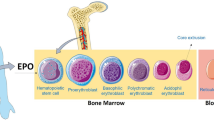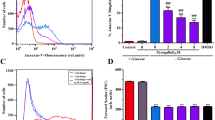Abstract
Palytoxin (PTX) is classified as one of the most powerful marine biotoxins (of high molecular weight and no protein origin) because it is able to interact strongly with important cellular structures influencing their function in different biological processes. This study of the effects of PTX on red blood cells (RBC) extends the knowledge about its toxicity, which concerns not only the well-known action on Na+/K+-ATPase but also band 3 protein (B3 or AE1), the role of which is essential for anion transport and for the structure, function, and metabolic integrity of the erythrocyte. The effects of PTX on RBC can be summarized as follows: it alters the anionic flux and seriously compromises not only CO2 transport but also the metabolic modulation centered on the oxy–deoxy cycle of hemoglobin; it stabilizes the plasma membrane by preventing lipid peroxidation; and its effect does not lead to activation of caspases 3 and 8. From what is reported in steps 2 and 3, and on the basis of the results obtained on hemolysis, methemoglobin levels, and phosphatase activity, an increase of the reducing power of the erythrocytes (RBC) in the presence of PTX clearly emerges. The results have enabled us to outline some metabolic adaptations induced in the RBC by PTX.






Similar content being viewed by others
References
Artigas P, Gadsby DC (2003) Ion occlusion/deocclusion partial reactions in individual palytoxin-modified Na/K pumps. Ann N Y Acad Sci 986:116–126
Artigas P, Gadsby DC (2004) Large diameter of palytoxin-induced Na/K pump channels and modulation of palytoxin interaction by Na/K pump ligands. J Gen Physiol 123:357–376
Barreca D, Laganà G, Tellone E, Ficarra S, Leuzzi U, Galtieri A, Bellocco E (2009) Influences of flavonoids on erythrocyte membrane and metabolic implication through anionic exchange modulation. J Memb Biol 230:163–171
Beaugè LA, Glynn IM (1979) Occlusion of K ions in the unphosphorylated sodium pump. Nature 280:510–512
Bellocci M, Sala GL, Prandi S (2011) The cytolytic and cytotoxic activities of palytoxin. Toxicon 57:449–459
Cantley LC, Resh M, Guidotti G (1978) Vanadate inhibits the red cell (Na+/K+)-ATPase from the cytoplasmic side. Nature 272:552–554
Chhatwal GS, Hessler HJ, Habermann E (1983) The action of palytoxin on erythrocytes and resealed ghosts. Formation of small, nonselective pores linked with Na+, K+-ATPase. Naunyn Schmiedebergs Arch Pharmacol 323:261–268
Ciminiello P, Dell’Aversano C, Fattorusso E, Forino M, Magno S, Tartaglione L, Grillo C, Melchiorre N (2006) The Genoa 2005 outbreak. Determination of putative palytoxin in Mediterranean Ostreopsis ovata by a new liquid chromatography tandem mass spectrometry method. Anal Chem 78:6153–6159
dos Remedios CG, Chhabra D, Kekic M, Dedava IV, Tsubakihara M, Berry DA, Nosworthy NJ (2003) Actin binding proteins: regulation of cytoskeleton microfilaments. Physiol Rev 83:433–473
Ficarra S, Tellone E, Giardina B, Scatena R, Russo A, Misiti F, Clementi ME, Colucci D, Bellocco E, Laganà G, Barreca D, Galtieri A (2009) Derangement of erythrocytic AE1 in beta-thalassemia by caspase 3: pathogenic mechanisms and implications in red blood cell senescence. J Membr Biol 228:43–49
Frelin C, Van Renterghem C (1995) Palytoxin. Recent electrophysiological and pharmacological evidence for several mechanisms of action. Gen Pharmacol 26:33–37
Gallitelli M, Ungaro N, Addante LM, Silver NG, Sabbà C (2005) Respiratory illness as reaction to tropical algal blooms occurring in a temperate climate. JAMA 293:2599–2600
Galtieri A, Tellone E, Romano L, Misiti F, Bellocco E, Ficarra S, Russo A, Di Rosa D, Castagnola M, Giardina B, Messana I (2002) Band-3 protein function in human erythrocytes: effect of oxygenation-deoxygenation. Biochim Biophys Acta 1564:214–218
Galtieri A, Tellone E, Ficarra S, Russo A, Bellocco E, Barreca D, Scatena R, Laganà G, Leuzzi U, Giardina B (2010) Resveratrol treatment induces redox stress in red blood cell: a possible role of caspase 3 in metabolism and anion transport. Biol Chem 391:1057–1065
Giardina B, Messana I, Scatena R, Castagnola M (1995) The multiple functions of hemoglobin. Crit Rev Biochem Mol Biol 30:165–196
Glynn IM (1988) How does the sodium pump pump? In: Gunn RB, Parker JC (eds) Cell physiology of blood. Rockefeller University Press, New York, pp 1–17
Habermann E (1989) Palytoxin acts through Na+, K+-ATPase. Toxicon 27:1171–1197
Habermann E, Chhatwal GS (1982) Ouabain inhibits the increase due to palytoxin of cationic permeability of erythrocytes. Naunyn Schmiedebergs Arch Pharmacol 319:101–107
Hilgemann DW (2003) From a pump to a pore: how palytoxin opens the gates. Proc Natl Acad Sci USA 100:386–388
Hughes FM Jr, Bortner CD, Purdy GD, Cidlowski JA (1997) Intracellular K+ suppresses the activation of apoptosis in lymphocytes. J Biol Chem 272:30567–30576
Ikeda M, Mitani K, Ito K (1988) Palytoxin induces a nonselective cation channel in single ventricular cells of rat. Naunyn Schmiedebergs Arch Pharmacol 337:591–593
Janoshazi A, Solomon AK (1989) Interaction among anion, cation and glucose transport proteins in the human red cell. J Membr Biol 112:25–37
Jin XR, Abe Y, Li CY, Hamasaki N (2003) Histidine-834 of human erythrocyte band 3 has an essential role in the conformational changes that occur during the band 3-mediated anion exchange. Biochemistry 42:12927–12932
Kim SY, Wu CH, Bèress L (1991) Palytoxin forms ion channels through Na, K-ATPase. In: De Weer P, Kaplan JH (eds) The sodium pump: recent developments. Rockefeller University Press, New York, pp 505–508
Kim SY, Marx KA, Wu CH (1995) Involvement of the Na,K-ATPase in the induction of ion channels by palytoxin. Naunyn Schmiedebergs Arch Pharmacol 351:542–554
Lang F, Busch GL, Ritter M, Volkl H, Waldegger S, Gulbins E, Haussinger D (1998) Functional significance of cell volume regulatory mechanisms. Physiol Rev 78:247–306
Läuger P (1991) Electrogenic ion pumps. Sinauer Associates, Sunderland
Lepke S, Fasold H, Pring M, Passow H (1976) A study of the relationship between inhibition of anion exchange and binding to the red cell membrane of 4,4′-diisothiocyanato-stilbene-2,2′-disulfonate (DIDS) and of its dihydroderivative (H2DIDS). J Membr Biol 29:147–177
Lewis IA, Campanella ME, Markley JL, Low PS (2009) Role of band 3 in regulating metabolic flux of red blood cells. Proc Natl Acad Sci USA 106:18515–18520
Louzao MC, Cadige E, Vieytes MR, Sasaki M, Fuwa H, Yasumoto T, Botana LM (2006) The sodium channel of human excitable cells is a target for gambierdol. Cell Physiol Biochem 17:257–268
Louzao MC, Ares IR, Vieytes MR, Valverde I, Vieites JM, Yasumoto T, Botana LM (2007) The cytoskeleton, a structure that is susceptible to the toxic mechanism activated by palytoxins in human excitable cells. FEBS J 274:1991–2004
Louzao MC, Ares IR, Cagide E (2008) Marine toxins and the cytoskeleton: a new view of palytoxin toxicity. FEBS J 275:6067–6074
Lux SE, Palek J (1995) Disorders of the red cell membrane. In: Handin RI, Lux SE, Stossel TP (eds) Principles and practice of hematology. JB Lippincott, Philadelphia, pp 1701–1818
Maccaglia A, Mallozzi C, Minetti M (2003) Differential effects of quercetin and resveratrol on band 3 tyrosine phosphorylation signalling of red blood cells. Biochem Biophys Res Commun 305:541–547
Mandal D, Baudin-Creuza V, Bhattacharyya A, Pathak S, Delaunay J, Kundu M, Basu J (2003) Caspase 3-mediated proteolysis of the N-terminal cytoplasmic domain of the human erythroid anion exchanger 1 (band 3). J Biol Chem 278:52551–52558
Misiti F, Orsini F, Clementi ME, Masala D, Tellone E, Galtieri A, Giardina B (2008) Amyloid peptide inhibits ATP release from human erythrocytes. Biochem Cell Biol 86:501–508
Moore RE, Scheuer PJ (1971) Palytoxin: a new marine toxin from a coelenterate. Science 172:495–498
Moore RE, Bartolini G, Barchi J, Bothmer-By A, Dadok J, Ford J (1982) Absolute stereochemistry of palytoxin. J Am Chem Soc 104:3776–3779
Muller-Berger S, Karbach D, Kang D, Aranibar N, Wood PG, Ruterjans H, Passow H (1995) Role of histidine 752 and glutamate 699 in pH dependence of mouse band 3 protein-mediated anion transport. Biochemistry 34:9325–9332
Muramatsu I, Uemura D, Fujiwara M, Narahashi T (1984) Characteristics of palytoxin-induced depolarization in squid axons. J Pharmacol Exp Ther 231:488–494
Muramatsu I, Nishio M, Kigoshi S, Uemura D (1988) Single ionic channels induced by palytoxin in guinea-pig ventricular myocytes. Br J Pharmacol 93:811–816
Onuma Y, Satake M, Ukena T, Roux J, Chanteau S, Rasolofonirina N, Ratsimaloto M, Naoki H, Yasumoto T (1999) Identification of putative palytoxin as the cause of clupeotoxism. Toxicon 37:55–65
Ozaki H, Nagase H, Urakawa N (1985) Interaction of palytoxin and cardiac glycosides on erythrocyte membrane and (Na++ K+) ATPase. Eur J Biochem 152:475–480
Passow H (1986) Molecular aspects of band 3 protein-mediated anion transport across the human red blood cell membrane. Rev Physiol Biochem Pharmacol 103:61–223
Rhodes L, Munday R (2004) Palytoxins: a risk to human health? In: Proceedings of the 20th marine biotoxin science workshop, Wellington, New Zealand, New Zealand Food Safety Authority
Rhodes L, Towers N, Briggs L, Munday R, Adamson J (2002) Uptake of palytoxin-like compounds by shellfish fed Ostreopsis siamensis (Dinophyceae). N Z J Mar Freshw Res 36:631–636
Romano L, Peritore D, Simone E, Sidoti A, Trischitta F, Romano P (1998) Chloride–sulphate exchange chemically measured in human erythrocyte ghosts. Cell Mol Biol 44:351–355
Romero N, Denicola A, Radi R (2006) Red blood cells in the metabolism of nitric oxide derived peroxinitrite. IUBMB Life 58:575–580
Russo A, Tellone E, Ficarra S, Giardina B, Bellocco E, Lagana G, Leuzzi U, Kotyk A, Galtieri A (2008) Band 3 protein function in teleost fish erythrocytes: effect of oxygenation–deoxygenation. Physiol Res 57:49–54
Satoh E, Ishii T, Nishimura M (2003) Palytoxin-induced increase in cytosolic-free Ca2+ in mouse spleen cells. Eur J Pharmacol 465:9–13
Sauviat MP (1989) Effect of palytoxin on the calcium current and the mechanical activity of frog heart muscle. Br J Pharmacol 98:773–780
Sterling D, Reithmeier RA, Casey JR (2001) A transport metabolon. Functional interaction of carbonic anhydrase II and chloride/bicarbonate exchangers. J Biol Chem 276:47886–478894
Tanner MJ (1997) The structure and function of band 3 (AE1): recent developments. Mol Membr Biol 14:155–165
Tellone E, Ficarra S, Giardina B, Scatena R, Russo A, Clementi ME, Misiti F, Bellocco E, Galtieri A (2008) Oxidative effect of gemfibrozil on anion influx and metabolism in normal and beta-thalassaemic erythrocytes: physiological implications. J Membr Biol 224:1–8
Tosteson ML, Halperin JA, Kishi Y, Tosteson DC (1991) Palytoxin induces an increase in the cation conductance of red cells. J Gen Physiol 98:969–985
Tosteson ML, Scriven DR, Bharadwaj AK, Kishi Y, Tosteson DC (1995) Interaction of palytoxin with red cells: structure–function studies. Toxicon 33:799–807
Uemura D, Ueda K, Hirata Y, Iwashita T, Naoki H (1985) Further studies on palytoxin II. Structure of palytoxin. Tetrahedron Lett 22:1007–1017
Vilariño N, Ares IR, Cadige E, Louzao MC, Vievtes MR, Yasumoto T, Botana LM (2008) Induction of actin cytoskeleton rearrangement by methyl okadaate—comparison with okadaic acid. FEBS J 275:926–944
Vince JW, Reithmeier RA (2000) Identification of the carbonic anhydrase II binding site in the Cl−/HCO3− anion exchanger AE1. Biochemistry 39:5527–5533
Wiles JS, Vick JA, Christensen MK (1974) Toxicological evaluation of palytoxin in several animal species. Toxicon 12:427–433
Xie Z, Askari A (2002) Na+/K+-ATPase as a signal transducer. Eur J Biochem 269:2434–2439
Yagi K, Rastogi R (1979) Assay for lipid peroxides in animal tissues by thiobarbituric acid reaction. Annu Rev Biochem 95:351–358
Zhang D, Kiyatkin A, Bolin JT, Low PS (2000) Crystallographic structure and functional interpretation of the cytoplasmic domain of erythrocyte membrane band 3. Blood 96:2925–2933
Zijlstra WG, Buursma A, Meeuwsen-Van Der Roest WP (1991) Absorption spectra of human fetal and adult oxyhemoglobin, de-oxyhemoglobin, carboxyhemoglobin and methemoglobin. Clin Chem 37:1633–1638
Zipser Y, Piade A, Barbul A, Korestein R, Kosower NS (2002) Ca2+ promotes erythrocyte band 3 tyrosine phosphorylation via dissociation of phosphotyrosine phosphatase from band 3. Biochem J 368:137–144
Author information
Authors and Affiliations
Corresponding author
Rights and permissions
About this article
Cite this article
Ficarra, S., Russo, A., Stefanizzi, F. et al. Palytoxin Induces Functional Changes of Anion Transport in Red Blood Cells: Metabolic Impact. J Membrane Biol 242, 31–39 (2011). https://doi.org/10.1007/s00232-011-9374-6
Received:
Accepted:
Published:
Issue Date:
DOI: https://doi.org/10.1007/s00232-011-9374-6




